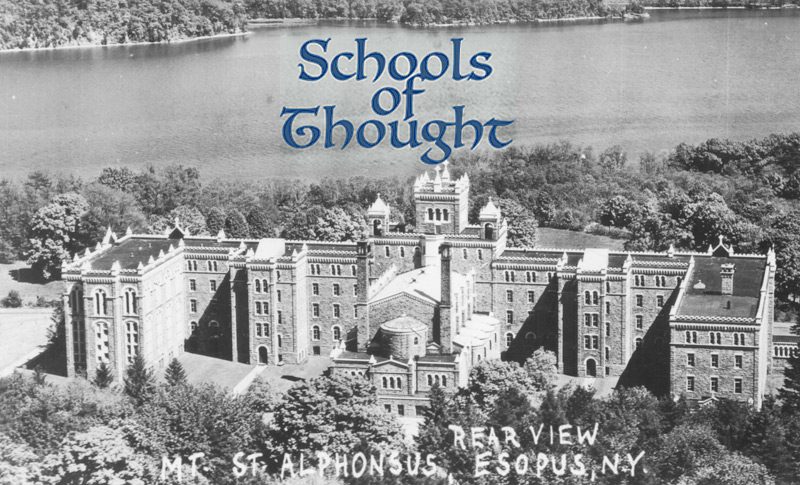
Mt. St. Alphonsus Seminary
Schools of Thought
Winter 2018
I chose “Luminari” for the title typeface of this article because it captures the spirit of the camps, colonies, and schools that have fed the minds and imaginations of countless students from every socio-economic strata. Some of those schools evolved (above B&W postcard of the Mt. St. Alphonsus Seminary, now The Mount, a private high school), a few thrived, and a few continue in their original mission, (color postcard below, St Mary’s School in Kingston). Most left barely a trace (below, Public School Kerhonkson, NY).
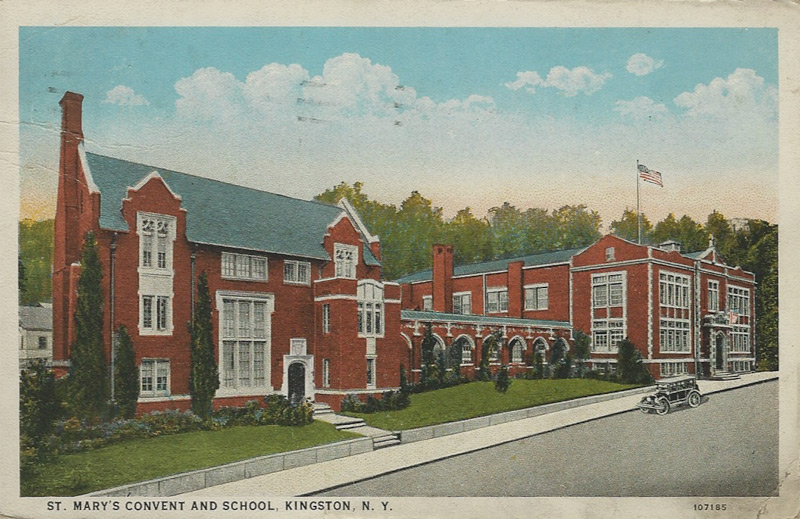
St Mary’s School in Kingston
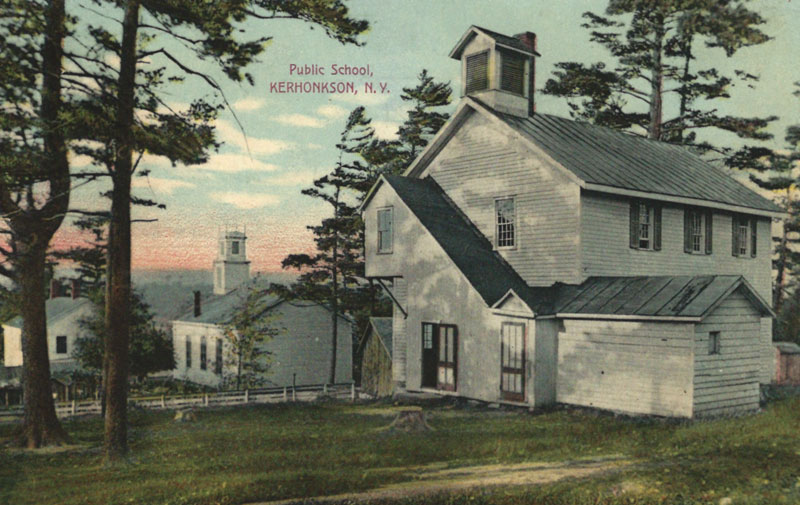
Public School, Kerhonkson, NY
“Every mind was made for growth, for knowledge, and its nature is sinned against when it is doomed to ignorance.”
William Ellery Channing (1780-1842), American theologian
In researching material for a book on the Raymond Riordan School (1914-1940) in Highland, New York, I realized how much of our educational history can disappear in the span of just a half-century. The number and variety of private places that once imparted moral compasses, wisdom, skills, artistic appreciation, political philosophy, civics, and “the three Rs” are impressive. Each competed for the minds and hearts of Ulster and Dutchess residents, and the occasional outlander.

Gallandet (sic) Home for Deaf Mutes, Poughkeepsie, NY. Postmarked 1909. The home opened in 1855. Gallaudet, the correct spelling, was an Episcopal Priest. His Father, a physician specializing in treating the deaf.
Business schools, prep schools, socialist labor schools, various orders of Catholic schools, Protestant and Catholic Seminaries, Steiner-Waldorf schools, Montessori schools, colleges, and industrial schools added to a blossoming of schools of thought. Special homes for the afflicted also educated their populations. Poughkeepsie, New York, had at least three nurses training programs: The Hudson River Psychiatric Center (1913-1978), Vassar Hospital (1905-1974), and St. Francis Hospital (1850-?).
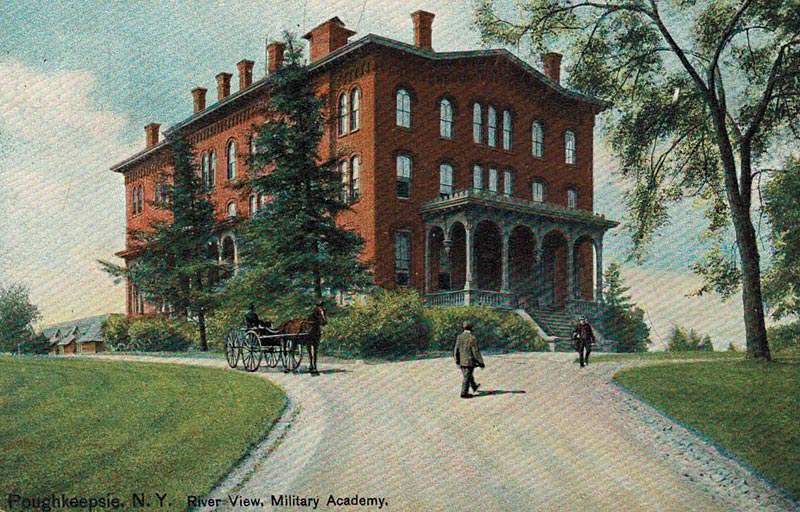
Riverview Military Academy, Poughkeepsie, NY. PM 1915. One of several buildings.
A 1912 Ulster County map indicates the location of each town’s public schools by assigning them numbers. The Plutarch School is #5 in the Town of New Paltz. In the Town of Esopus, the Dashville School is #16, and the West Park School is #11. Each town numbered its schools from #1 to #x to include all the public schools in its jurisdiction. These were mostly one, two, or three-room affairs going to the eighth grade. Many schools were sans indoor plumbing. The rare high school was usually in the larger communities and many were private.

St. Mary’s School, Saugerties. Undated.
But this story is primarily about the non-public institutions available to those seeking a different or specialized path. Many Ulster residents commuted to Poughkeepsie for training in places such as the Eastman Business College, which was started in 1859 by the then 25-year-old Harvey G. Eastman, who also served as Mayor of Poughkeepsie. The Eastman College used hands-on teaching of business practices and was at one time the largest commercial school in the United States. The school featured prominently in many an early resume or the obituary of its graduates.

Ulster Academy, postmarked 1912.
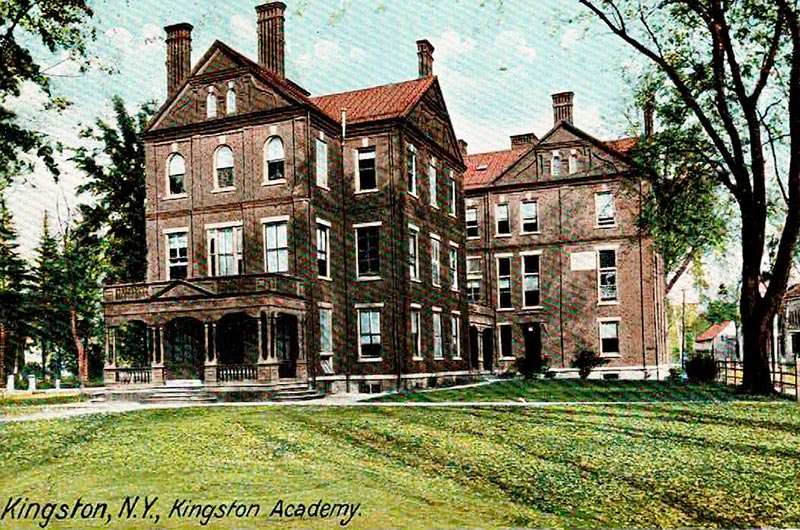
Kingston Academy, postmarked 1907.
Two early Ulster County institutions at opposite ends of the spectrum regarding facilities size were the castle-like Mount St. Alphonsus seminary (1907-2012) in Esopus, New York, and the camp-like Raymond Riordon School in Highland, New York.
The most physically imposing of the non-public schools in Ulster County continues to be the gray-granite Redemptorist Mount St. Alphonsus Seminary. St. Alphonsus Liguori founded the Redemptorists, a Roman Catholic order of priests and brothers in Naples, Italy, in 1732 to serve the spiritual and material needs of the faithful, especially the poor. The American seminary was founded in Esopus in 1907. (See black and white postcard at top of article). The huge seminary building was constructed between 1904 and 1907 on what grew to be 400 acres on the west bank of the Hudson River. It featured a chapel, 92 bedrooms, large meeting rooms, classrooms, a kitchen, and a library.

Mt. St. Alphonsus photo, east face.
When Mount St. Alphonsus Seminary closed in 2012, the huge library collection was put in storage. Two years later, Freeman Auctioneers, Philadelphia sold 4,000 volumes valued at more than $700,000 from that collection. Freeman Auctioneers book specialist Kerry Jeffery singled out one volume in particular: “There is also a slightly disturbing lot called ‘The Hammer of Witches’, dated 1620, valued at $1,000-$1,500. Essentially this was a ‘how-to’ book to identify witches, arguing that witches were mostly always women rather than men…” Other books in the library were less controversial; for instance, a Latin manuscript circa 1450, sold for $20,480.
During its history, more than 1,300 Redemptorist priests were ordained during the seminary years at its St. Alphonsus Chapel, an ornate Romanesque worship space adorned with seven altars, beautiful German stained-glass windows, and paintings and statues. The walls are three feet thick and the floors are marble. One display in a chapel of priceless artifacts dating back hundreds and thousands of years was said to contain bone fragments of some of Jesus’ apostles, as well as from popes and saints.
The building stopped serving the Redemptorist order in 1985 and became a retreat center. On January 1, 2012, it was reportedly purchased for $23 million dollars for use as a private high school, the Mount Academy. Today, it is a New York State-registered, private high school serving 200 students from all American Bruderhof communities, a Christian movement in which material wealth is communally owned. The property is private and well-supervised. Consult www.bruderhof to learn more.
From that grand and comfortable structure on the banks of the Hudson River to the most rustic of schools, we travel a few miles south to the Raymond Riordon School in Highland, New York. This boys’ prep school, similar to many evolving in the early 1900s, was inspired by one man’s vision of what young men needed to lead personally– and civically–successful lives.
Raymond Riordon came to the attention of Gustav Stickley, the mission furniture magnate, when Riordon’s articles on educational philosophy appeared in Stickley’s Craftsman magazine. Stickley recruited Riordon to run a school he had planned for a property in New Jersey. Unfortunately, the Stickley School for Boys did not materialize. Riordon then found property on Chodikee Lake in Highland. He and his wife opened the Riordon School on March 17, 1914, a few months before the June 14th assassination of Franz Ferdinand by Gavrilo Princip leading to the outbreak of World War I. When the United States became involved in the War in 1917, some students of the Riordon School served, as did at least one of its future instructors.
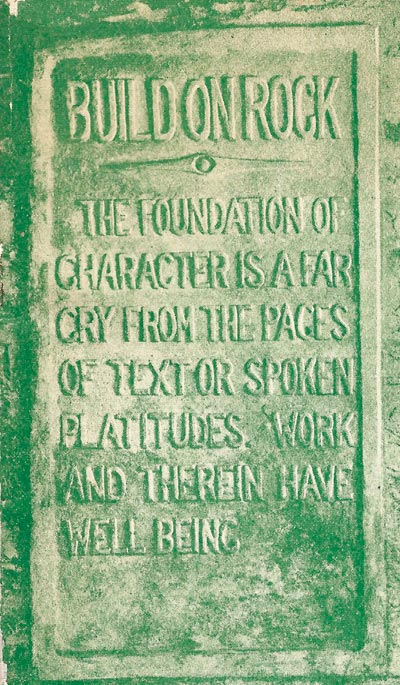
Build on Rock image is from a Riordon School brochure. The plaque may have been constructed by the students as it looks much like work done on other monuments they erected.
Riordon and Stickley, who became a board member of Riordon School, shared the belief that the best education was one that engaged the whole boy, that is, positively stimulated the physical, mental, and spiritual aspects of becoming civilized and productive. The school curriculum was rigorous and demanding.
Riordon boys often built their own housing and outbuildings; tended the school’s heating systems and gardens; chopped wood; built accommodations at Elverhoj (an art colony in Milton, NY) for visiting teams of Intercollegiate crew; helped to fight forest fires; planted tens of thousands of trees in the Catskills; built cement monuments; rode horses on treks of hundreds of miles; and lived on a steamship (The Southland, image below) for three months in winter while they studied first-hand American government in Washington, D.C.
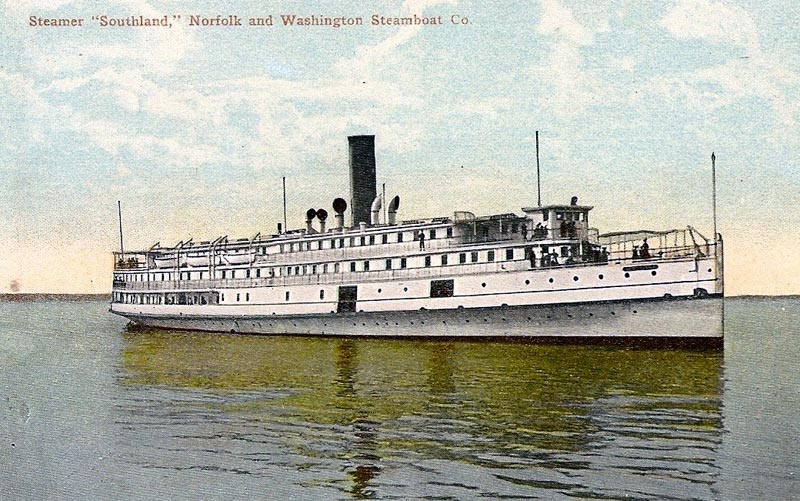
Postcard image of the SS Southland where the boys from the Riordon School spent three months each winter near Washington, DC to study government. They sometimes used classrooms of William and Mary College and the Continental Hotel in Washington, DC.
The boys took age-appropriate courses in everything from aeronautics—the school owned three airplanes—to Latin, art, poetry, math, and the sciences. They played baseball, basketball, and football against most local public school teams. The Riordon boys engaged in philanthropy by supporting various fundraising efforts such as the American Olympic teams.
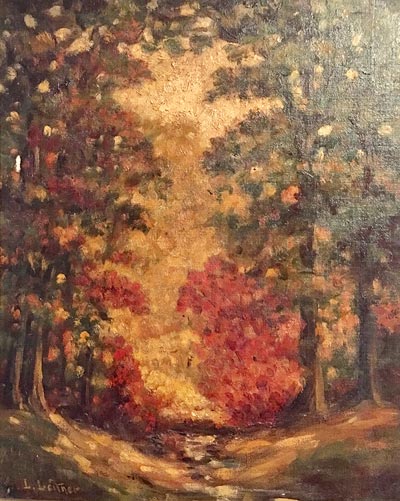
Original Leander Leitner oil painting. Leitner served as the Riordon School Art Director.
One Riordon brochure listed a teaching staff that included “…Chief Crazy Bull (Ta Tan Ka Witko)—grandson of the heroic warrior of the Sioux, Sitting Bull…” Chief Crazy Bull taught outdoor skills, archery, and horsemanship. (The school owned 150 horses.) Other school staff included World War I flying ace, Col. Earl C. Popp, who went on to design many regional airports and was a friend of Amelia Erhart, and poet-artist Leander Leitner (see painting at right). Leitner’s biography on askart.com states: “While serving as the Director of the art department at Raymond Riordon School for Boys in Highland, New York, he received an honorary doctor’s degree from New York University. Leitner also wrote poetry and illustrated poetry books and magazines; three poetry books by him were published, as well as a monograph on the history and migration of the Lene-Lenape (sic) Indians. His interest in Native America Tribes and painting of their legends led to his becoming an adopted member of the American Indian Association. He was given the name Running Beaver, or O-Mis-Tai-Po-Kah, in the language of the Blackfeet tribe.”
Most of Riordon’s students were from out of state. One local student was Andrew Lent, who became an Ulster County attorney and lived in Highland. Lent’s daughter, Emily, former Librarian of the Highland Library, was witness to Riordon’s will. The late Richard Lent, of New Paltz, who became an attorney, also attended.
Riordon died suddenly, and for a short time his brother ran the school. It then moved briefly to Milton, NY, where it closed for good. At the time of Riordon’s death, the school had about 100 students. His obituary appeared in almost every major newspaper across America.

Interior of the Continental Hotel where the Riordon students had classes in American government for three months each winter.

Interior of main building of the Riordon School and the Chodikee Lake Hotel. It burned on Christmas Day, 1915, driving hotel guests and Riordon students into the cold, some in their nightclothes.
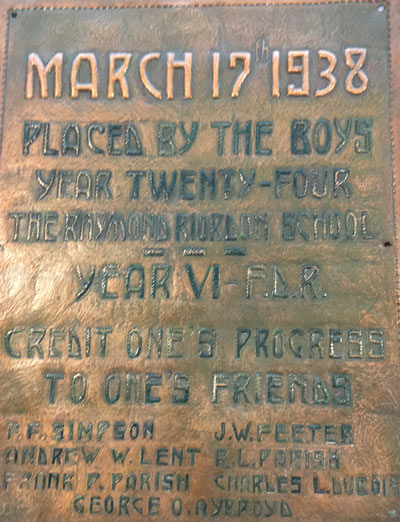
One of the 24 hand-embossed copper plaques from the Riordon School’s graduating classes covering most of the years from 1915 to 1939. The plaque reads: “March 17th, 1938. Placed by the boys year twenty-four. The Raymond Riordon School. Year VI-FDR. Credit One’s progress to one’s friends. F.F. Simpson, J. W. Feeter, Andrew W. Lent. R.L.Parish, Frank P. Parish, Charles L. duBois, George O. Aykroyd”
No buildings of the Riordon School remain. However, a number of the cement monuments built by the boys still exist. One, at Rochester Hollow in Shandaken, NY, is dedicated to their friend, nature writer John Burroughs. A collection of hand-tooled copper plaques, one executed each year by the graduating seniors, also remains. Today, the Riordon school land still serves young men. The Highland Residential Center is a treatment and training center for at-risk boys. In the end, this New York State center is also an institution of education.
Other educational hopefuls of the era focused on more cultural and aesthetic pursuits. One such institution was Ernest Williams Band and Orchestra Camp in Saugerties, NY. Born in 1881 in Indiana to a musical family, Ernest Williams became one of the premier American cornet and trumpet soloists. He served in the 158th and 161st Regiments of Indiana Volunteer Infantry in the Spanish American War.
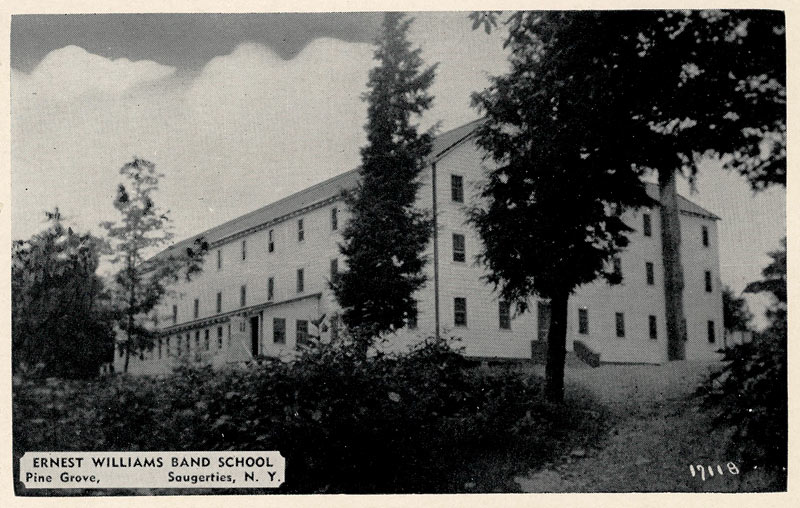
Ernest Williams Band School postcard, no postmark, circa 1947.
Later, as a well-regarded trumpeter, Williams played with the likes of John Phillip Sousa. After an illustrious career with large bands and orchestras, and as a composer, Williams was elected to the American Bandmasters Hall of Fame.
Williams developed his first School for Music in Brooklyn in the 1920s, and in 1930 built his Saugerties Band Camp. He died in 1947. One year later the building (pictured above) burned and was never rebuilt. The camp was located on Band Camp Road in Saugerties.
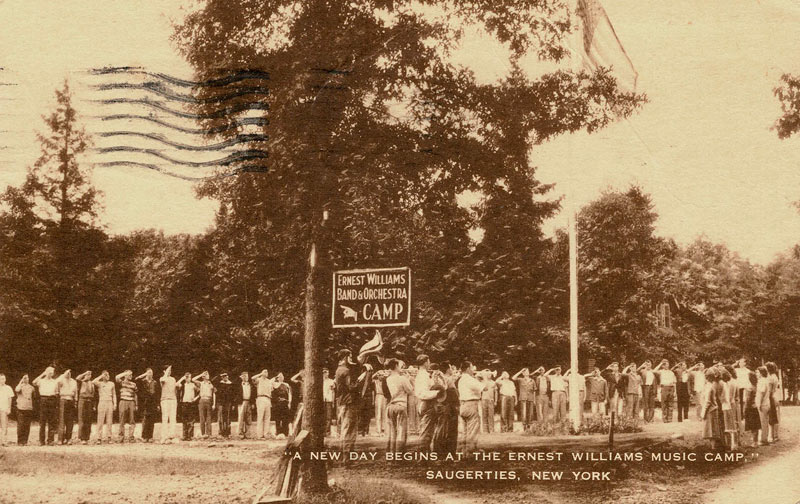
Postcard postmarked 1944, card face “A new day begins at the Ernest Williams Music Camp, Saugerties, New York.” The note reads in part, “Dear Gloria, I wanted to tell you that camp is grand. This summer I was maid of honor at the marriage of Gladys Rice and Dr. Williams last Sat, July 8 in a nice Dutch church in Woodstock…”
In addition to the magnificent Mount St. Alphonsus and the rustic Riordan School were many other contemplative or experiential educational opportunities. Artist colonies proliferated in Ulster County around the turn of the 20th century. Woodstock’s Byrdcliffe, Milton’s Elverhoj, Hyde Park’s Val-Kill, and others sought to bring skills, training, and aesthetic appreciation to those interested. The colonies trained wood and metal workers, painters, jewelers, performers, and writers.
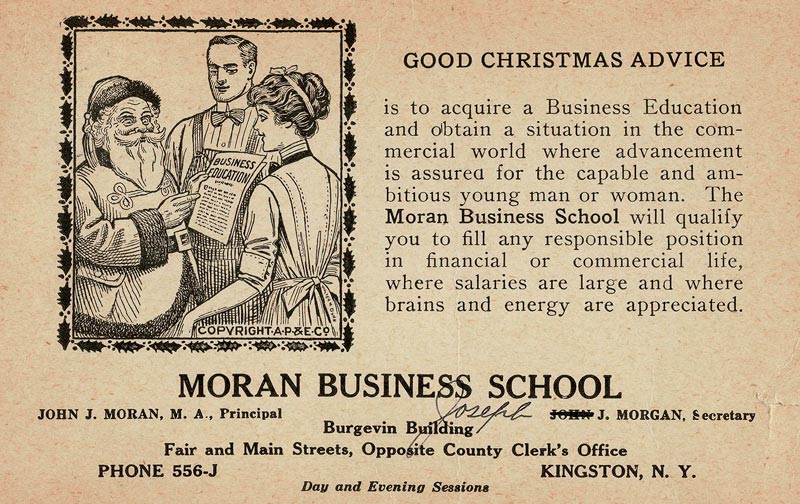
Christmas greeting postcard from the Moran Business School in Kingston, NY, postmarked 1916, telling the recipient in part, “…The Moran Business School will qualify you to fill any responsible position in financial or commercial life, where salaries are large and where brains and energy are appreciated. Phone 556-J.”
An online search today for private schools delivers a variety of paths to self-actualization and self-expression. Few, however, offer the variety of experiences of a Riordon School or a Mount St. Alphonsus School.
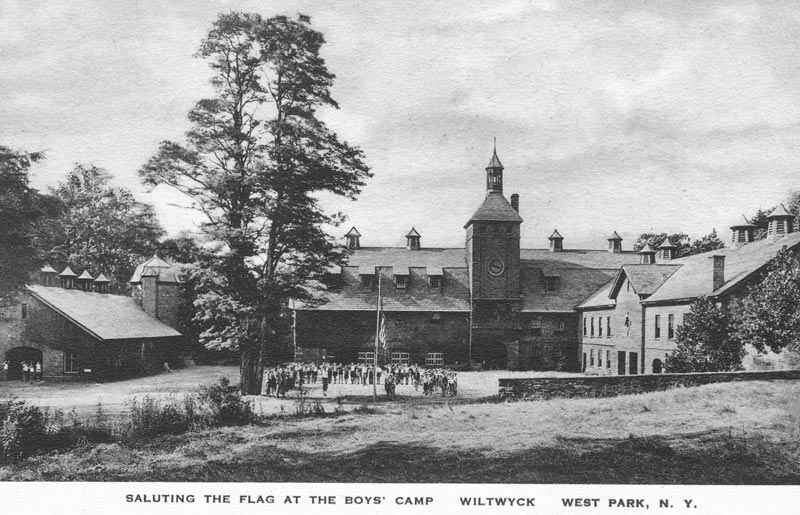
Postcard: “Saluting the flag at the boys’ camp. Wiltwyck. West Park, NY”
Buildings above are not in use today. One of the most famous youngsters to get his start at this school was Olympic Boxing Champion, Floyd Patterson. He went on to live in New Paltz for many years. His son, Tracy Patterson, has a boxing school in the Highland village, and opened a second location in Poughkeepsie in June of 2018.

Postcard: “School House at St. Remy, NY. Building was substantially renovated and is no longer recognizable. The Art Noveau border is embossed.

Photo postcard for the Manrosa School, West Park, NY.
Unless otherwise noted all images are from the Collection of Vivian Yess Wadlin.
